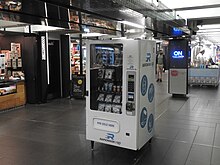COVID-19 pandemic in New York City
[24] It was reported that "Urban Area Medical Task Forces" made up of army reservists would be working in the New York City field hospitals and other parts of the country.
[31] On June 8, the city commenced the first phase of its reopening plan after meeting seven conditions of the stay-at-home order, which had been put in place three months earlier.
[33] Plans to open indoor dining during the Phase 3 reopening were postponed due to the heightened risks posed by customers refusing to wear face masks and the uncertain role of air conditioning for COVID spread.
The Tunnels to Towers foundation held a simultaneous memorial nearby at Zuccotti Park where around 125 family members took part in reading names.
[44] Despite calls from health experts to close indoor dining before it was too late "to reverse the tide of new infections", the governor's office declined to impose restrictions until the statistical thresholds were met.
[44] The school-closure policy was partly reversed less than two weeks later, with de Blasio announcing that elementary schools would resume in-person learning from December 7.
[56] On July 7, 2021, the city held a "Hometown Heroes" ticker tape parade to honor healthcare professionals and essential workers for their work during the pandemic.
[58] The Uniformed EMS Officers Union also asked its members not to attend the parade due to an ongoing dispute with the city over a lack of hazard pay during the pandemic.
[59] On July 23, 2021, the city's health department announced that daily average cases were 32% higher than the prior week and that the Delta variant had become the dominant COVID strain, accounting for 57% of citywide samples over a four-week period.
[60] On August 2, 2021, de Blasio recommended that vaccinated people wear masks in indoor settings, following CDC guidance and a continued uptick in positive COVID cases due to the Delta variant.
[62] On August 3, de Blasio announced that New York City would become the first in the United States to require proof of vaccination for workers and customers at all indoor dining establishments, gyms, entertainment venues, and performances.
"[67] New York City Council members Robert Holden and Eric Ulrich wrote to Mayor de Blasio asking him to relieve Barbot of her position.
[69] On April 20, de Blasio announced that major events had been cancelled through June, including the Pride March and the Puerto Rican Day Parade.
[70] On August 5, de Blasio announced that COVID-19 checkpoints would be set up at major crossings and tunnels to help enforcement of a mandatory 14-day quarantine for travelers from areas of a high transmission rate per Cuomo's order, in coordination with the New York's Sheriff department.
[71] Failure to comply with this order would result in fines ranging from $2,000 to $10,000 with de Blasio adding, "We're not going to let our hard work slip away and will continue to do everything we can to keep New Yorkers safe and healthy.
[78] On March 17, despite de Blasio's message to New Yorkers that they should be "prepared right now" for the possibility of "shelter in place" orders, Cuomo expressed doubts about whether the policy would be effective.
New York City issued new commuter guidelines following the start of the outbreak, asking sick individuals to stay off public transit, and encouraging citizens to avoid densely packed buses, subways, and trains.
Their request to shut down the subway was initially rejected by the governor's office[111] and criticized by interim New York City Transit President Sarah Feinberg.
[127] On October 4, the Daily News reported that an epidemiologist affiliated with Yale University recommended that the MTA should advise riders not to talk to reduce the risk from spreading infectious aerosols.
[143] On September 17, de Blasio announced the shift of the start of the school year again, opting for a phased approach, due to continued obstacles including teacher shortages.
[154] On July 16, the High Line reopened to the public with free timed-entry passes in order to limit capacity and allow social distancing.
[171] By April 2020, The New York Times reported that hundreds of thousands of New Yorkers were unemployed, with at least $7.4 billion lost tax revenue projected over the year, and many residents uncertain as to how their rents would be paid.
A significant percentage of populations in all five boroughs were estimated to be receiving unemployment insurance benefits, with rates ranging from 22% of the workforce in Manhattan to 41% in the Bronx.
[204] During May and June 2020, fears arose of a second wave of COVID-19 accelerated by the George Floyd protests, close confinement of those detained, and poor rates of mask wearing by law enforcement.
[241] A study published in JAMA Network Open found New York City's COVID-19 death rates in the spring of 2020 were comparable to the peak of the Spanish flu, per capita.
[249][250] Field hospitals were also proposed at the New York Expo Center in the Bronx, Aqueduct Racetrack in Queens, the Brooklyn Cruise Terminal, and the College of Staten Island.
[253] Due to rules constraining transfers and preventing 911 calls from going there, it remained mostly empty as at least three COVID-19 patients quarantining at home died and nearby hospitals exceeded capacity.
[253] Although the number of new patients admitted to the hospitals started to slow in early April, Cuomo stated that social distancing protocols would continue to be enforced to prevent a rise in these figures that could overwhelm the strained healthcare system.
[257][258] The senior director of the System-wide Special Pathogens Program at NYC Health + Hospitals Syra Madad, who worked through the first wave in spring, said, "We never want this to happen again", referring to the nearly 20,000 deaths from COVID-19 in New York City.
[265] On May 1, 2020, the New York State Department of Health issued fresh COVID-19 guidelines for the Medicaid providers serving low-income families, adult care facilities (including nursing homes), and physically disabled individuals.




















